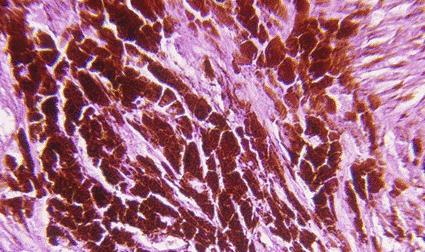Potential Melanoma Drug Blocks Melanocyte Development
By LabMedica International staff writers
Posted on 04 Apr 2011
Using zebrafish as the model organism, cancer researchers have demonstrated the potential use of the antirheumatoid arthritis drug leflunomide for the treatment of malignant melanoma.Posted on 04 Apr 2011
Investigators at the University of East Anglia (Norwich, United Kingdom) and the Harvard Medical School (Boston, MA, USA) worked with zebrafish embryos to seek drugs that would act on melanoma, a tumor of transformed melanocytes, which are originally derived from the embryonic neural crest.

Image: Human malignant melanoma, level V, in skin cells (photo courtesy of Biodisc, Visuals Unlimited).
They performed a chemical genetic screen to identify small-molecule suppressors of the neural crest lineage, which were then tested for their effects on melanoma. Results published in the March 24, 2011, issue of the journal Nature revealed that inhibitors of dihydroorotate dehydrogenase (DHODH), for example leflunomide - a drug commonly used to treat rheumatoid arthritis - led to an almost complete inhibition of neural crest development in the zebrafish embryos. The drug also caused a reduction in the self-renewal of mammalian neural crest stem cells in culture. Leflunomide exerted these effects by inhibiting the transcriptional elongation of genes that are required for neural crest development and melanoma growth.
When leflunomide was used in combination with PLX4720, a specific inhibitor of the BRAF(V600E) gene - a promising new melanoma therapy currently undergoing clinical trials - the results were even more profound with almost complete blockage of tumor growth in a mouse xenograft model system.
"This is a really exciting discovery - making use of an existing drug specifically to target melanoma,” said contributing author Dr. Grant Wheeler, senior lecturer in cell and developmental biology at the University of East Anglia. "Deaths from melanoma skin cancer are increasing and there is a desperate need for new, more effective treatments. We are very optimistic that this research will lead to novel treatments for melanoma tumors which, working alongside other therapies, will help to stop them progressing.”
Related Links:
University of East Anglia
Harvard Medical School













